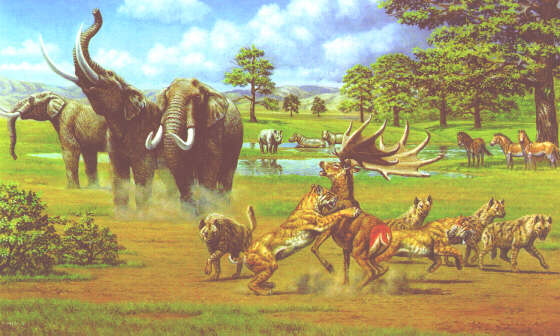 |
 |
 |
 |
 |
Produced
by the Population Genetics and Evolution class, Furman University |
||||
 |
 |
 |
 |
 |
Produced
by the Population Genetics and Evolution class, Furman University |
||||
 |
The
Neogene: Proconsul |
 |
||
| Primate-like
creatures evolved as far back as the Mesozoic Era; however, true primates
did not evolve until the Eocene Epoch (O'Neil 2009). Apes evolved from
monkeys during the Miocene epoch (O'Neil 2009); in fact, as many as 100
species of apes have been dated to this epoch (WRPRC 2003). Proconsul
was an early genus of primates from the Miocene epoch (Wikipedia 2010).
Moreover, Proconsul was one of the earliest monkey to ape transitional
primates (O'Neil 2009). Proconsul and other ape species on the
Miocene epoch varied considerably in size (3-80 kilograms) and their diets,
ranging from leaves to ripe fruit (WRPRC 2003). Proconsul fossils
provide a good idea of the basic anatomy and locomotion of apes during
early stages of radiation (WRPRC 2003); however, Proconsul still
posess monkey-like characteristics (Wikipedia 2010). The monkey-like features
included: thin tooth enamel, light build with narrow chest and short forelimbs,
curved metacarpals, long flexible back and a quadrupedal lifestyle. The
ape-like characteristics included: no tail, large lateral supracondylar
region, and a larger brain relative to body size (Wikipedia 2010). Moreover,
like modern apes, they posses more mobile hips, shoulders, wrists, ankles,
hands and feet compared to monkeys (WRPRC 2003). Page by Matt Medlin |
 |
| Proconsul. Photo from: Maricopa College | |
|
Wikipedia. 2010. Proconsul (primate). Wikipedia, The Free Encyclopedia. Accessed April 20, 2010. O'Neil D. 2009. The First Primates. Anthro.palomar.edu. Accessed April 20, 2010. Wisconsin Regional Primate Research Center (WRPRC). 2003. Planet of the Apes. Primates.com. Accessed April 20, 2010. |